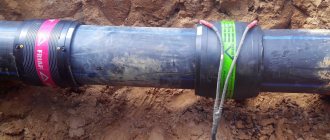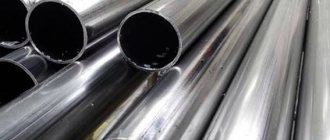The most important part of the construction, repair and reconstruction of private houses, municipal and industrial facilities is the design and installation of engineering systems and communications, and the construction of gas pipelines.
To build a gas pipeline, it is necessary that a gas pipeline be installed near the facility, to which it can be connected. In the absence of such a pipeline, autonomous solutions are used to gasify facilities (most often, cylinder units and tanks are used).
Strict requirements are imposed on the design and construction of gas pipelines. Current legislation obliges property owners to enter into contracts for any work related to gasification exclusively with specialized licensed organizations.
Our company is such an organization. We professionally and efficiently carry out the construction of gas pipelines in Moscow and the Moscow region. Our specialists have all the necessary approvals and permits, as well as many years of experience and many successfully completed projects.
To contact us, fill out the electronic feedback form on our website or call the numbers listed in the contact information section. Our specialists will advise you on all issues related to gasification and gas pipeline construction.
Main stages of installation of a gas supply system
Installation of a gas supply system for a facility under construction or already constructed involves the implementation of several successive stages:
- obtaining permission to carry out excavation work (gas pipeline construction);
- development of a gas pipeline construction project;
- execution of construction and installation works;
- conducting instructions on the safe operation of gas and gas equipment;
- concluding an agreement for the supply of gas to the facility;
- concluding a contract for connecting the constructed gas pipeline to the existing main network;
- conclusion of an agreement for the initial launch of blue fuel;
- conclusion of a maintenance contract;
- obtaining a document confirming ownership of the constructed gas pipeline.
Thus, the construction of a main gas pipeline involves solving a number of issues, such as preparing documentation, obtaining permits and approvals, designing and laying gas pipeline pipes on the site. That is why the work should be entrusted to professionals who understand all the intricacies and features of gasification.
Construction of a local gas pipeline and connection of a private house to the gas main
The construction of local gas pipelines is carried out if there is no centralized gas pipeline in the immediate vicinity of the facility. At the same time, the features of the facility, the owner’s wishes regarding the use of gas and, of course, safety requirements are taken into account.
When installing local gas pipelines, gas boilers are installed and contracts are concluded for the supply of blue fuel in the required volume.
Of course, connecting to a centralized highway is cheaper and more reliable. Local gas pipelines require searching for reliable and responsible suppliers.
As for connecting to the central highway and laying a gas pipeline to a private house, installation work can be carried out in the following ways:
- aboveground (the pipe is carried out in the open air);
- underground (gas pipeline is laid underground).
The first method is a little cheaper, but it requires constant monitoring and care of the gas main, and its protection from negative external factors.
Please note that all construction and installation work must be carried out in accordance with the developed and approved gas pipeline laying project. During the work, technical control must be carried out.
Gas pipeline in a private house
We carry out connection, laying and installation of gas pipelines in private houses in Moscow and the Moscow region under an official contract with a guarantee of results and compliance with strict deadlines. We will prepare a project, go through all stages of approval, lay external underground and internal gas pipes and introduce gas into the country house. We offer comprehensive gasification systems.
A gas pipeline in a private house is not only the key to uninterrupted operation of the heating system, but also the possibility of a complete transition to an autonomous energy supply through the installation of a gas generator. The advantages of natural gas need not be listed; suffice it to say that today there are no alternatives to it.
But the process of supplying gas to a private home is quite labor-intensive, multi-stage and really time-consuming. And just at the first stage, it is important to entrust the gasification of your home to specialists. This solution will help to avoid many difficulties and, ultimately, save not only time, but also the family budget.
Of course, you can use the information available on the Internet, but you must understand that the sites give either superficial advice or such confusing answers to questions, after studying which the idea arises that only the house that took into account during construction can be gasified all the nuances of the future summary. But most often it is necessary to install a gas pipeline into an already landscaped house or cottage. Therefore, it is impossible to do without a preliminary on-site examination by a specialized organization. If you order the service of installing a gas pipeline to a private house from the ENERGOGAZ Group of Companies, you will receive the most cost-effective and effective solution for installing the system and using natural gas for heating the house.
100% guarantee of connecting a private house to the main gas pipeline!
By concluding an agreement with the group, you receive a guarantee of gas connection to your cottage within a clearly defined time frame.
Work on laying a gas pipeline in a private house is carried out on a turnkey basis: concluding an official contract, obtaining technical conditions (agreement for technological connection), developing a gasification project, coordinating the project with all interested authorities, constructing a gas pipeline, handing over the gas pipeline to the acceptance committee, concluding agreements for commissioning work and maintenance, gas tapping and start-up.
Region of work: Moscow, as well as New Moscow, all districts of the Moscow region (near and far Moscow region).
Order Contacts
Features of construction and installation works
We should dwell on the construction and installation work in more detail. The construction and installation organization carries out the work provided for by the project. These works usually include:
- determination of work sites and zones;
- delivery of necessary materials and equipment to the site;
- aboveground or underground pipe laying;
- performing welding work;
- implementation of measures for electro-chemical and corrosion protection of the gas pipeline.
After completion of construction and installation work, a hydraulic test of the constructed gas pipeline is carried out (pressure test with compressed air).
When laying an underground gas pipeline, the terrain, the presence or absence of other utilities nearby, and the movement of vehicles and agricultural machinery above the gas pipeline must be taken into account.
All work is carried out in strict accordance with the requirements of SNiP 42-01-2002, SP 42-102-2004 and other regulatory documents.
During the work, the contractor prepares as-built documentation for the constructed gas pipeline, which includes permits, working drawings indicating the laid gas pipeline, certificates of work performed, research protocols, etc. All documentation is subsequently agreed upon with the gas service and regulatory structures, after which, if the work is completed correctly and there are no complaints about its quality, the final acceptance certificate for the constructed gas pipeline is signed.
Trenching Methods
There are only two methods for digging trenches for laying pipes underground:
- manual;
- mechanized.
If the installation takes place in an open area, where there is no fear of damaging existing underground communications, for example, water pipes, it is more advisable to use a mechanized method. Special equipment (Excavator) will quickly and accurately dig a trench of the required depth.
If work is carried out on the territory of other underground communications, the use of special equipment is prohibited, since it can easily damage or puncture a pipe lying in the ground, which is fraught with a number of consequences. In this case, manual trench digging is used.
Trench requirements
According to the requirements for laying an underground gas pipeline, the depth of the trench must be below the soil freezing zone. In St. Petersburg and the Leningrad region, the laying depth of the gas pipeline is 140 cm. In some cases, for example, if the trench passes under a highway, the laying depth increases. The width of the trench directly depends on the diameter of the pipe being laid; there are no special requirements here. After the trench is dug, a sand cushion is made and polyethylene pipes are laid on it.
A representative of the gas operating organization must be present and check the quality of the work.
After the pipe has been laid, make a 20 cm layer of sand. Be sure to lay down the warning tape “CAUTION GAS”, it serves as a signal that a gas pipeline passes through this place. Next, the trench is filled with the remaining soil. After the trench is buried, it is necessary to mark the location of the pipe with signs that are attached to the facade or fence of the house and indicate all the information about the gas pipeline (depth, pipeline plan).
There are a number of other requirements that must be met:
- The position of the pipeline must clearly correspond to the work design.
- When laying pipes, the external insulation of the pipe must not be damaged.
- The joints of the pipes and the connection with the main gas pipe must be strong and airtight.
- The bottom of the trench must be cleared of debris, stones and other objects that may cause mechanical damage to the gas pipeline.
- When laying the pipe, the “bed” under the gas pipeline should not be changed.
Requirements for the materials used and installation of the gas network
When constructing and laying a gas pipeline to a facility, it is necessary to comply with certain requirements for materials and installation:
- all pipes, valves and other materials used must be of high quality and have the necessary certificates;
- free access to collapsible joints should always be provided - this allows you to monitor their condition and, if necessary, carry out repairs;
- pipes and elements of the gas network cannot be built into walls or foundations and access to them cannot be blocked (in some cases, pipes can run in a wall channel if this is provided for in the design documentation);
- Do not attach the gas pipeline to window and door frames, plywood partitions;
- When laying local gas pipelines, distortions are not allowed.
In addition, it is important to maintain safe distances:
- the gas pipe must be located at least 2.2 meters above the floor and at least 10 centimeters below the ceiling;
- the distance from the pipe to the wall must be provided for in the design documentation (in this case, the distance cannot be less than the diameter of the pipe and more than 10 centimeters).
Gas pipeline installation technique
Autonomous gas supply system
Work begins with introducing the pipe into the building. To do this, a case is placed in the outer wall and an entry is made through it. A riser is already installed inside, located 20 mm from the walls in a vertical position. Connections at this stage are made using a welding machine.
The cases should be located at all intersections of the pipe with interfloor ceilings, walls and staircases.
Gas pipeline fasteners must be installed at a distance of at least 2 m from each other. These rules apply to pipes with a diameter of 25 mm. They must allow repairs and diagnostics of possible damage during operation. The end of each fastener is driven into a special wooden plug located in the wall. After this, the fastening site is filled with cement mortar to give additional strength.
There are a number of rules for performing welding work:
Rules for performing welding work
- Welding can be performed on pipes with a diameter not exceeding 150 mm and with a wall thickness of up to 5 mm.
- Arc welding is used when the pipe thickness exceeds 150 mm or the wall thickness exceeds 5 mm.
- Before installation, it is necessary to prepare the pipes for welding. To do this, they are cleaned of contaminants.
- Each welded joint must be easily accessible. It is not allowed to hide seams in the wall or case.
It is important to note that free access is required for all connections, not just welds.
All connections are made by welding. Threaded connections are allowed only in places where shut-off valves, metering devices (gas meters) are installed, and where a pipe is connected to a hose leading directly to gas equipment.











